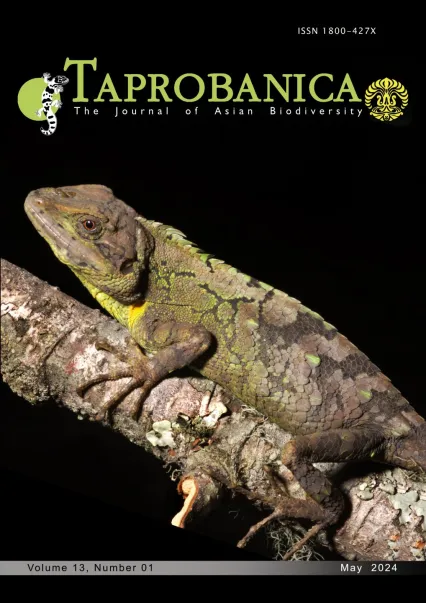

v13i1.320
Volume 13 | Number 1 | May 2024
Short Note
ISSN: 1800-427X (printed)
eISSN: 1800-427X (online)
DOI:10.47605/tapro.v13i1.320
Submitted date: 6 June 2023
Accepted date: 30 April 2024
Published date: 30 May 2024
Pp. 25.
An opportunistic mating attempt of a flower crab spider (Thomisus sp.), India
A. Mhadgut*
*Corresponding author. E-mail: naturetalks2320@gmail.com
Flower crab spiders of the genus Thomisus, Walckenaer, 1805 have a crab-like habitus with its first two pairs of legs that are long and robust. The Thomisus spiders do not build webs, but instead capture their prey using ambush, or sometimes by active pursuit hiding in flowers, leaves, and leaf litter. Some species flatten their bodies to hunt inside crevices or tree trunks under loose bark. Most of the Thomisus species are sexually dimorphic, males are much smaller than females. On 2 November 2020, I observed a female crab spider capturing a chestnut bob butterfly (Lambrix salsala) while it was trying to feed on the nectar of Jamaican spike flowers, Stachytarpheta jamaicensis (Verbenaceae) in the Butterfly Garden located at Sanjay Gandhi National Park (SGNP), Maharashtra, India.
Section Editor: Ayan Mondal
eISSN: 1800-427X (online)
DOI:10.47605/tapro.v13i1.320
Submitted date: 6 June 2023
Accepted date: 30 April 2024
Published date: 30 May 2024
Pp. 25.
An opportunistic mating attempt of a flower crab spider (Thomisus sp.), India
A. Mhadgut*
*Corresponding author. E-mail: naturetalks2320@gmail.com
Flower crab spiders of the genus Thomisus, Walckenaer, 1805 have a crab-like habitus with its first two pairs of legs that are long and robust. The Thomisus spiders do not build webs, but instead capture their prey using ambush, or sometimes by active pursuit hiding in flowers, leaves, and leaf litter. Some species flatten their bodies to hunt inside crevices or tree trunks under loose bark. Most of the Thomisus species are sexually dimorphic, males are much smaller than females. On 2 November 2020, I observed a female crab spider capturing a chestnut bob butterfly (Lambrix salsala) while it was trying to feed on the nectar of Jamaican spike flowers, Stachytarpheta jamaicensis (Verbenaceae) in the Butterfly Garden located at Sanjay Gandhi National Park (SGNP), Maharashtra, India.
Section Editor: Ayan Mondal
- List of Articles & Contents





